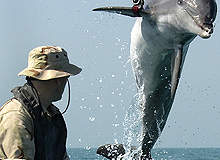
In early 2010, a Toggenberg goat became the honorary member of 609 (West Riding) squadron based at RAF Leeming and was picked because of his resemblance to “William de Goat” who was taken on as the squadron’s mascot during World War II. But it isn’t just the air force that has an animal for its mascot, the US Marine Corps has used bulldogs since 1922 and many regiments of the British Army have animals as mascots. The parachute regiment, for example, has a Shetland pony and the 95th Derbyshire Regiment has had a ram as a mascot since 1858, always known as Private Derby, he attends all parades and special engagements.
Bomb sniffers in Afghanistan
A black Labrador by the name of Treo hit headlines in the UK in early 2010 for his bomb sniffing skills, after being recognised in an official ceremony during which he was awarded the prestigious Dickin Medal (equivalent to the Victoria Cross, but for animals) to honour his achievements. The award has been given to many animals over the years, including 32 pigeons, three horses and a cat.
Treo was its 63rd recipient, and was awarded the honour after he uncovered a series of Taliban bombs in 2008 around Helmand Province, a major insurgency hot spot. According to the Ministry of Defence news, back in 2008 Treo discovered an improvised explosive device (IED), a “daisy chain” IED (two or more explosives wired together) at the side of a path. A month later he located another daisy chain device saving more lives. Treo has worked with his handler, Sergeant Dave Heyhoe, for around five years.
The navy’s underwater guards
The navy’s work with marine mammals has been in progress for many years, but only really got started in the 1950s when the understanding of a dolphin’s hydrodynamics became more developed after the navy realised that dolphins could work as valuable assistants to divers due to the fact they can repeatedly dive without suffering human deficiencies such as the bends or decompression sickness.
Mine hunting is another way in which dolphins are used by the navy. According to the US Navy, sea mines have been responsible for 14 out of the 19 navy ships destroyed or damaged since 1950.
The detection systems are mk4, mk7 and mk8 – the first (mk4) locates mines tethered off the ocean floor, the second system (mk7) uses dolphins trained to detect mines buried in the sediment of the ocean’s bottom and the third (mk8) identifies safe corridors for troops to land ashore.
What all systems have in common is the general way in which handler and dolphin work together. A dolphin will wait to receive a cue from its handler before using its biological sonar (echolocation) to search a targeted area. The process of echolocation means the dolphin gives off a series of clicks that bounce and return to the dolphin allowing it to construct a mental image of the object – when the dolphin returns to the handler it communicates a certain response if the target object is detected (if this is deduced to be a mine target the dolphin returns in order to confirm the location so it can be avoided by troops) and gives off a different response if no target object is detected.
It isn’t just dolphins that had useful skills to complement navy divers, sea lions were also discovered to be highly reliable and trainable to search for and find objects in the water. Dolphins and sea lions have also been used to work together to protect navy-restricted areas against trespassers or unauthorised swimmers and divers.
Known as mk6, this strategy of using mammals to protect such areas was first deployed during the Vietnam War in 1971. Sea lions were used to support missions In Bahrain in 1986 and are now used to detect swimmers or divers and, by quietly approaching from behind, can now attach a clamp, connected to a rope, to the swimmer’s leg.
Sea lions have underwater directional hearing and can see in the dark, so they make the perfect day and night watchman for restricted areas that need protection.
Air force K9 – drug and bomb detection
Air forces rely heavily on the skill of their K9 partners – and in the US it is the air force that trains working dogs for the entire US military. It is thought that there are over 1,300 working dog handler teams worldwide. The two most important jobs a dog can carry out for the air forces is bomb sniffing and drug detection. The dogs learn how to recognise and detect the presence of bombs and explosives hidden in luggage, packages and other materials. Once a handler and a dog are paired they work together to become a trained detection team. When it comes to drug interdiction, a dog’s training consists of live field training exercises using real drug supplies – part of the training is actually carried out along the border with Mexico, because of the sheer amount of drugs passing through.
US Army caisson horse teams
During the old horse-drawn artillery days, one horse from each team would be mounted while the other carried provisions and feed.
In honour of this tradition the caisson platoon of the 3rd US Infantry (also known as the Old Guard) have six horses (paired into three teams) charged with the duty of escorting any service member killed in action and those in the rank of sergeant major or higher to the Arlington National Cemetery.
While all six are saddled, it is only the horses on the left who have mounted riders, which is in keeping with tradition. The caisson horses work approximately eight funerals each day (out of around 16 to 22) as a full-time job.



